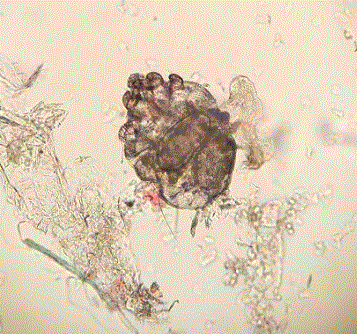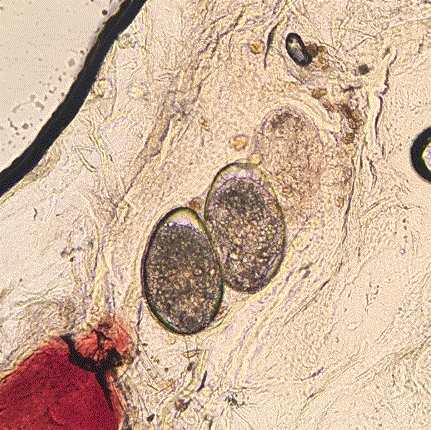Scabies Mite from a mineral oil prep
Scabies
The video at the bottom of the page shows a moving baby scabies mite (nymph) next to several eggs. The smaller darker debris is the scybala (feces).
History:
Scabies infestation may be the first disease of man for which a cause was definitively known when the mite was identified in 1687, and there are potential references to the condition going back to 1200BC¹.
Symptoms:
Scabies infestation is marked by extreme itching in a characteristic distribution which may include finger web spaces, wrists, chest, armpits, groin which is typically significantly worse at night.
Transmission:
Scabies is transmitted through direct and extended skin to skin contact such as with close household family members or sexual partners. Outbreaks are also often seen in institutional settings such as nursing homes or prisons. Canine scabies can cause itching in humans but they are typically self resolved rather than the human mite which lives and reproduces on the skin. Scabies can theoretically be spread through clothing or bedding but this is a much less common source of transmission.
Life cycle:
Scabies burrow into the skin after mating where they survive on intracellular fluid. The females lay 2-3 eggs per day. A typical affected patient may only have 10-15 mites at any given moment. However, with crusted scabies (formerly Norwegian scabies) an immunocompromised patient may have hundreds of thousands.
Diagnosis:
Scabies diagnosis can be made based on the typical symptoms in conjunction with certain physical exam findings including the mite burrows as seen through a dermatoscope. Microscopic confirmation with a mineral oil preparation can be done in office through which the feces, eggs, or actual mites can be seen.
Treatment:
Treatment is usually with topical antiscabitic called permethrin 5% cream. It is applied to the entire body (neck down) at night and rinsed off in the morning. This treatment is repeated a second time one week later. Oral antiparasitic medicines are also sometimes used such as Ivermectin (which requires weight based dosing). Special considerations may be given to kids or pregnant females and a different treatment may be selected.
Important Note:
Close house-hold contacts and sexual partners must also be treated or re-infestation is likely. Re-infestation is the most common cause of treatment failure.
1.A review of Sarcoptes scabiei: past, present and future. Arlian and Morgan. Parasites & Vectors2017 10:297
Scabies egg


